In the Footsteps of Merlin: Exploring Tintagel
by Christina Hamlett
High on the jagged cliffs of England's southwestern coastline lay
not only the remains of a long abandoned castle but the mythical
birthplace as well of one of this country's most enduring
legends: King Arthur. Though many sites throughout the United
Kingdom stake claims of association to the chivalrous knights of
Camelot and their ladies fair, Tintagel holds sway as the
backdrop of both Alfred Lord Tennyson and Geoffrey of Monmouth's
respective tales of star-crossed lovers. Whether your taste in
adventure entertains acts of Medieval enchantment or favors the
more down to earth pursuits of modern archaeology, this is one
stop in Cornwall that you won't want to miss.
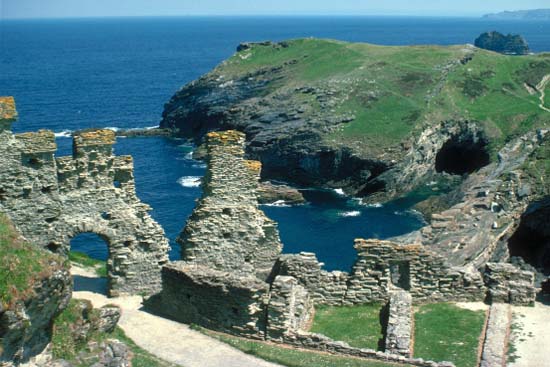
Tintagel is located approximately two miles north of Camelford
off the A39. Although the day was rainy when we first started
out -- and my travel companions' spirits equally damp at the
prospect of hiking around in it -- the remote and foreboding
setting lends itself to abandoning all sense of time. Sturdy
walking shoes or boots are a must, as the uneven surface trek to
the ruins themselves are combined with a initial hike from the
parking lot in the lower village almost half a mile away.
Gale force winds are also not uncommon here, sometimes prompting
early closure of the 10-6 admission hours. How strong are they,
you ask? Evidence of the North Atlantic's gusting power has left
a lasting impression at the parish church of St. Materiana on the
nearby Glebe Cliff where centuries old headstones have had to be
fortified with stone blocks just to keep them from toppling down
the hill.
To understand the significance of Tintagel's early use as an
encampment by Roman and Celtic warriors, one also needs to
appreciate the severe impact that Mother Nature and a steady dose
of erosion have had on the terrain. Connected to the mainland by
a narrow strip of land, the original fortress was the closest
thing to being its own, impenetrable island. Potential attackers
could neither storm the compound en masse nor navigate a ship
past the rocky perimeter. Perched several hundred feet above sea
level, this locale not only afforded a spectacular view of
everything around it but also the entrance to two shoreline caves
that run beneath the isle itself. The larger of the two, dubbed
"Merlin's Cave," was believed to be the hiding place where the
wily wizard sequestered the newborn Arthur from potential harm by
enemies of the Pendragon crown.
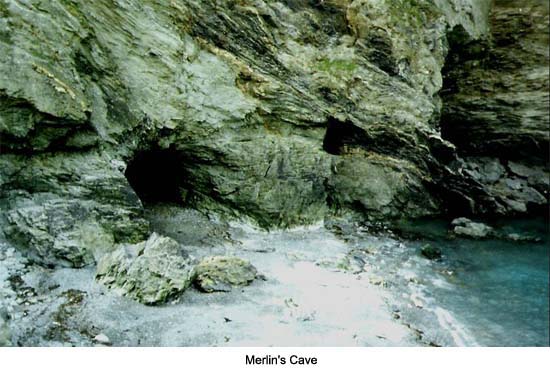
Whether or not this tale was true, the Arthurian legend
carried enough weight for Richard, the Earl of Cornwall, to erect
his own castle in the early 1200's directly atop the crumbled
remains of the 5th century stronghold. Ironically, the
nobleman's bravado to be recognized as "king of the hill" and
lend credence to Geoffrey of Monmouth's assertions about Arthur's
conception was somewhat deflated by the fact that the new castle
was a tad too remote for anyone to ever bother with launching an
assault.
Whilst waiting for a skirmish that never materialized, however,
Richard had plenty of malevolence to contend with in terms of the
wind and sea. This combination of elements began to leave their
mark in earnest, causing landslides and flooding that reduced the
constricted causeway even further and finally compelled the
Normans to abandon it altogether by the 14th century. According
to our guide, it is only a matter of time before the persistent
battering and tumble of falling rock off the headland and into
the sea will render this historic site inaccessible.
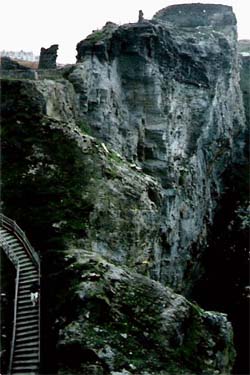 For
the present, however, a stroll amongst the roofless stone ruins
gives one an estimation of just how big the Earl of Cornwall's
castle actually was, coupled with a sense of awe for the
engineering and masonry feat of acquiring and assembling all of
the materials to begin with. The thick facades and steep stairs
that vary between broad and tiny comprise what was believed to be
the castle's Great Hall. A network of staircases and wooden
bridges resembling catwalks allow visitors to traverse what time
has washed away. The photo-ops are spectacular from this height.
Site officials recommend that you allow at least 2-3 hours of
exploration. For
the present, however, a stroll amongst the roofless stone ruins
gives one an estimation of just how big the Earl of Cornwall's
castle actually was, coupled with a sense of awe for the
engineering and masonry feat of acquiring and assembling all of
the materials to begin with. The thick facades and steep stairs
that vary between broad and tiny comprise what was believed to be
the castle's Great Hall. A network of staircases and wooden
bridges resembling catwalks allow visitors to traverse what time
has washed away. The photo-ops are spectacular from this height.
Site officials recommend that you allow at least 2-3 hours of
exploration.
Tourists, of course, aren't the only ones who find the area
compelling. Archaeological research has been in the works here
since the 1930's, yielding further clues about Tintagel's
origins. Among the findings have been Mediterranean crockery,
slate inscriptions, chards from glass vessels, and Byzantine
artifacts. In addition, an assemblage of several dozen stone
buildings unearthed on the eastern side of Tintagel Island have
raised speculation that a monastery may have occupied this
haunting ground as well.
Books, maps, and regional exhibits in the interpretive display at
the Tintagel Visitors Center will round out your knowledge after
you get back from your hike. In addition, the area is managed by
English Heritage, a respected commission which not only has
onsite experts to answer questions but website resources and
publications than can address anything you think of after you've
returned home. If you are a member of this organization, by the
way, your admission fee (£4) will be waived.
If you haven't soaked up enough Arthurian ambiance by now, pop
into King Arthur's Hall back at the village and its adjoining
exhibit of stained glass panels relating the daring deeds of
those fearless lads of the Round Table. This tourist venue was
the brainchild of a turn of the century millionaire named
Frederick Glassock who wanted others to share his excitement
about the days of chivalry. There's even a replica of the table
itself and plenty of literature and knick-knacks to fill in any
particulars that may be missing from your body of knowledge about
Camelot. Local rumor has it, by the way, that the real table
fell by the wayside along with the former standing spot of
Bossiney Castle a mile to the east.
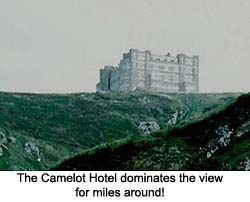 As you're scanning the
Tintagel landscape, one of the things that certainly won't escape
your attention is what looks to be an imposing manor house
sitting by itself on one of the nearby hills. One of my
companions, in fact, initially gasped in the mistaken delight
that that was the castle we had come to see and remarked on how
well kept-up it looked from a distance. This Victorian structure
is actually the former King Arthur's Castle Hotel and the site of
Alfred Lord Tennyson's inspiration behind Idylls of the
King. If you've had the foresight to plan your England trip
far in advance, you might be lucky enough to be bedding down
there for a stay. You're even luckier if your avocation is that
of an artist, as the owners of this establishment -- aptly
renamed The Camelot Castle Hotel -- invite writers, painters,
musicians and their respective muses to submit a residency
program application and, if accepted, enjoy their hospitality for
free. This myth-inspired haven is also a popular draw for film
crews and wedding parties. Additional information can be found
at their website. As you're scanning the
Tintagel landscape, one of the things that certainly won't escape
your attention is what looks to be an imposing manor house
sitting by itself on one of the nearby hills. One of my
companions, in fact, initially gasped in the mistaken delight
that that was the castle we had come to see and remarked on how
well kept-up it looked from a distance. This Victorian structure
is actually the former King Arthur's Castle Hotel and the site of
Alfred Lord Tennyson's inspiration behind Idylls of the
King. If you've had the foresight to plan your England trip
far in advance, you might be lucky enough to be bedding down
there for a stay. You're even luckier if your avocation is that
of an artist, as the owners of this establishment -- aptly
renamed The Camelot Castle Hotel -- invite writers, painters,
musicians and their respective muses to submit a residency
program application and, if accepted, enjoy their hospitality for
free. This myth-inspired haven is also a popular draw for film
crews and wedding parties. Additional information can be found
at their website.
In the mood for more hiking? Depending on your stamina level
and the cooperation of the season, there are two convergent
trails which will more than appease your quest for rugged scenery
and seascapes. The Cornwall Coast trek offers an alternative
view of the Tintagel ruins from Glebe Cliff. It's here that
you'll find the previously mentioned St. Materiana, poised on the
point like a small, celestial lighthouse. Whereas most places of
worship traditionally emerge as the hub of a burgeoning village,
the parish chapel predates the town of Tintagel itself and, like
the castle, was erected on the ruins of a prior structure.
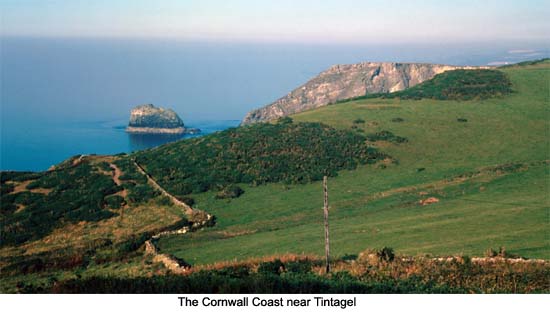
Proceeding southward on the trail, you'll come upon Trebarwith
Strand. This coastal path will take you past what used to be the
region's slate quarries. Since the 15th century, the removal of
slate from the cliffs not only constituted a thriving trade
industry but helped define territorial boundaries by stacking the
flat slabs similar to the more modern construction of making a
sturdy fence out of bricks. Slate, of course, was also a popular
material for roofing. Although the quarries were finally phased
out in the 1930's, the splitting sheds and the ruts made by horse
and donkey-powered anchoring blocks still remain. Long Grass
Quarry, the last of these mining operations to close, was
subsequently converted to a youth hostel to accommodate those who
wanted to spend more than just an afternoon hiking the landscape.
Since the coastline trails extend for several miles and can
cause you to forget the clock, you may want to keep an eye on the
skiesΙand on the ground. Many sections of it are steep and
slippery, not to mention that an umbrella will do you absolutely
no good when the wind decides to kick up.
Last stop on your day-trip to Tintagel is a pilgrimage to Saint
Nectan's Glen, a trek through Rocky Valley which is only
accessible by foot but well worth the reward of plenty of picture
taking opportunities. This pastoral setting with its
breathtaking waterfall was the location of a 6th century chapel
occupied by a man whom contemporary definitions would have
labeled a recluse. Whether through divine prayer or dark
incantation, the two women who saw to his burial arrangements
also diverted the course of the adjacent river to flow over the
top of his resting place. Such association with a "miracle" soon
transformed the glen into a destination of serenity and
contemplation. After a moment of providing sustenance for your
soul, this venue's tea garden offers sustenance for your tummy in
the form of beverages and modest snacks. With the exception of
winter months when the facility is only open on weekends, Saint
Nectan's Glen welcomes visitors on a daily basis.
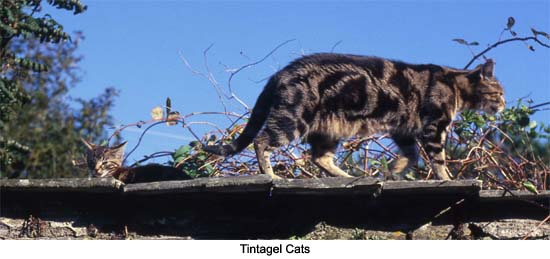
More Information:
We regret that we no longer have the resources to maintain up-to-date links and/or hours and pricing details for the various sites and attractions listed on this website. For more information about the location(s) listed above, please use your favorite search engine or visit Wikipedia.
Former actress and director Christina Hamlett is an award-winning author, instructor and script coverage consultant for the independent film industry. Her credits to date include 21 books, 115 plays and musicals, 4 optioned feature films, and columns that appear throughout the world. She and her husband reside in Pasadena, California.
Article © 2006 Christina Hamlett
Tintagel Stair, Merlin's Cave and Camelot Hotel photos © 2006 Christina Hamlett. Tintagel Ruins photo courtesy of Britainonview.com. Cornwall Coast and Tintagel Cats photos © 2006 Moira Allen.
|
